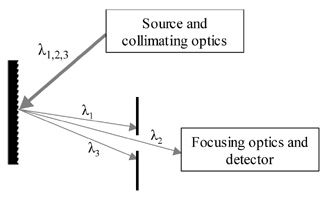Optipedia • SPIE Press books opened for your reference.
Dispersive Spectrometers
Excerpt from Fourier-Transform Spectroscopy Instrumentation Engineering
As the name suggests, dispersive spectrometers generate spectra by optically dispersing the incoming radiation into its frequency or spectral components, as illustrated in the figure below. Common dispersive elements include prisms and gratings. Dispersive spectrometers can be further classified into two types: monochromators and spectrographs. A monochromator uses a single detector, narrow slit(s) (usually two, one at the entrance and another at the exit port), and a rotating dispersive element allowing the user to observe a selected range of wavelength. The figure below shows the simplified schematic of a monochromator.
A spectrograph, on the other hand, uses an array of detector elements and a stationary dispersive element. In this case, the slit shown in the figure is removed, and spectral elements over a wide range of wavelengths are obtained at the same time, therefore providing faster measurements with a more expensive detection system.

Schematics of a monochromator; a dispersive spectrometer. Narrow slits (an input and an output slit) are used to select a particular spectral element whose wavelength depends on the beam's incident angle on the grating. (Only the output slit is shown in this figure.)
V. Saptari, Fourier-Transform Spectroscopy Instrumentation Engineering, SPIE Press, Bellingham, WA (2003).
View SPIE terms of use.

